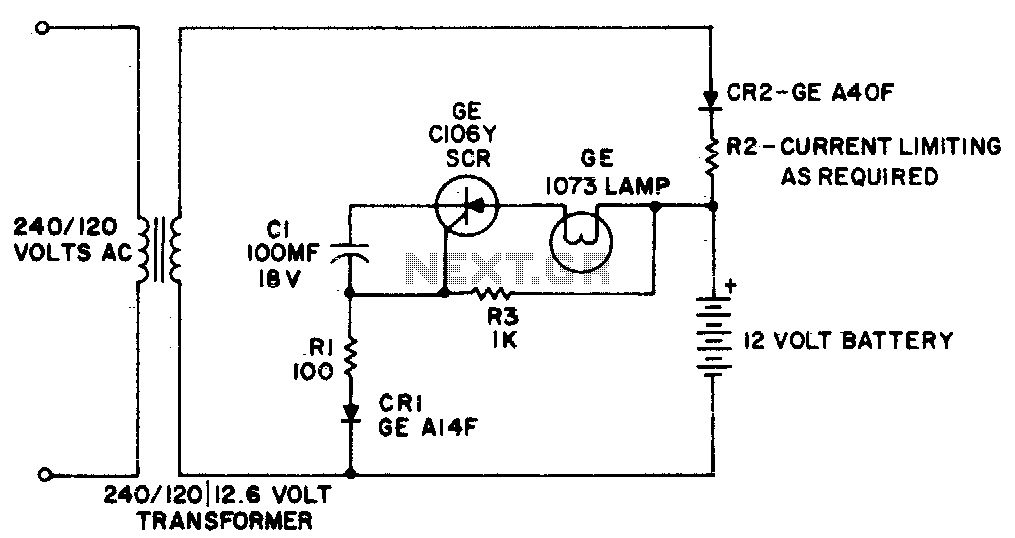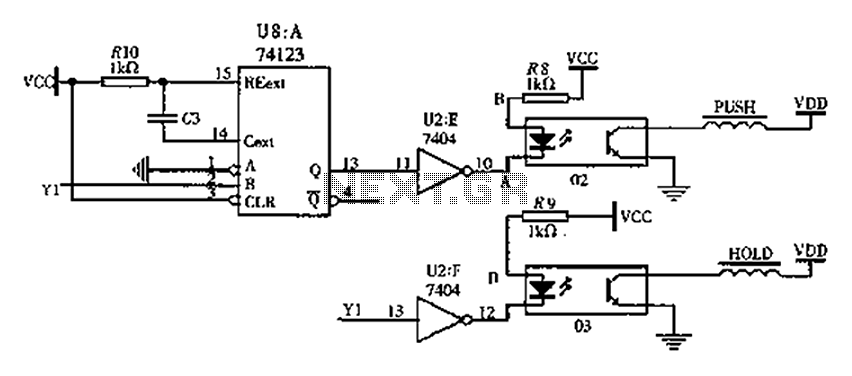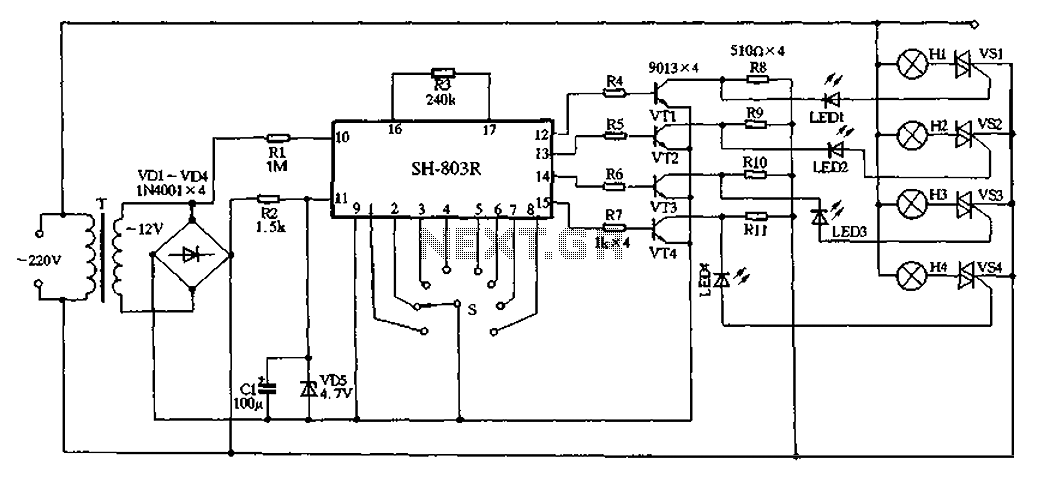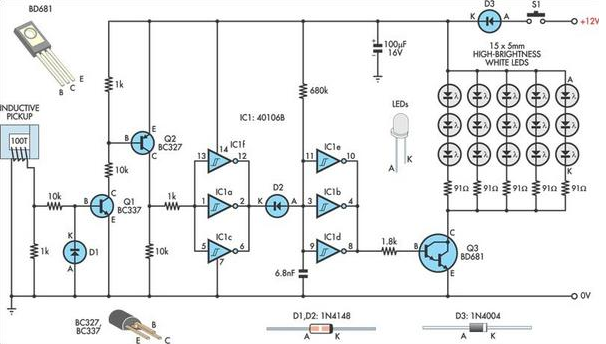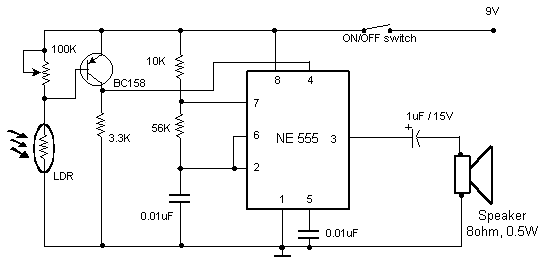
BH-SK-1 with the production of non-contact infrared light switch
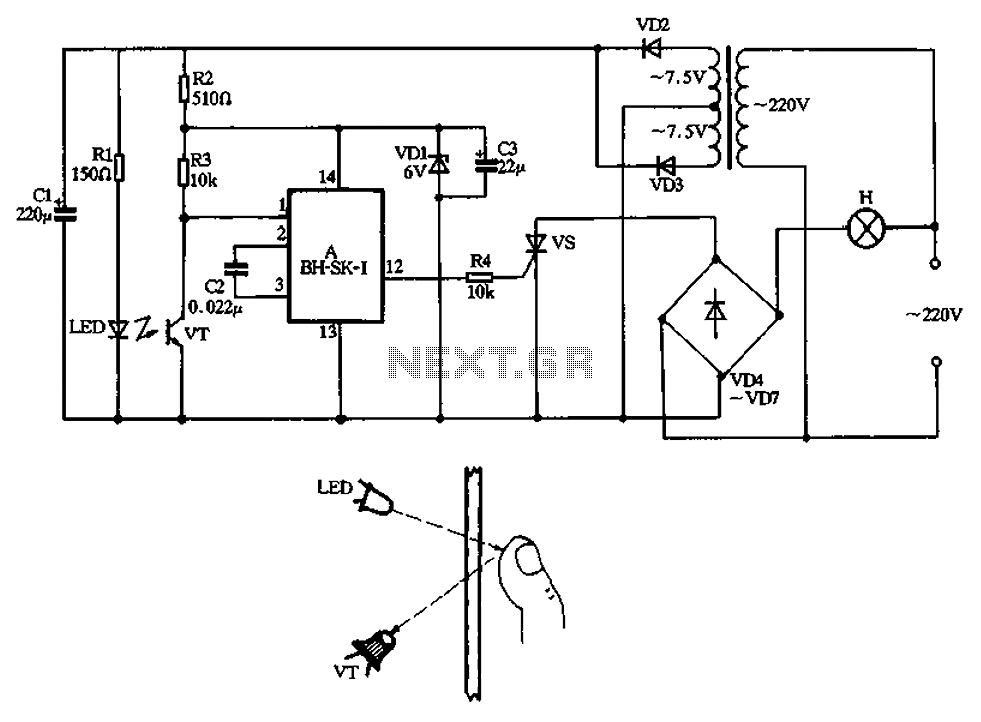
The non-contact infrared lamp switch circuit produced by BH-SK-I, as depicted in Figure 3-42, primarily consists of voice integrated circuits, an infrared light-emitting diode (LED), and a receiving tube. It includes a triac circuit and a power circuit. When the switch is activated, the triac allows current to flow, illuminating the lamp. When deactivated, the lamp turns off. The control loop is managed by the voice integrated circuits, infrared light-emitting and receiving components. The electrical control loop is powered by a transformer (T), with diodes VD2 and VD3 providing full-wave rectification and filtering, yielding an output voltage of approximately 8V DC. This voltage is regulated down to 6V DC by a simple circuit composed of resistors R2, VD1, and capacitor C3, supplying power to the voice integrated circuit. The phototransistor (VT) acts as an infrared receiver; to ensure proper alignment, the emitted infrared light must not directly hit the VT. In its idle state, the integrated circuit outputs a low power level at pin 12, keeping the lamp off. When a finger is waved in front of the switch panel, the reflected infrared light reaches the VT, reducing its equivalent resistance. This triggers a low signal at input pin 1, causing the internal bistable circuit to flip, changing the output at pin 12 from low to high, which turns on the lamp. Waving the hand again sends a trigger signal to pin 1, flipping the bistable circuit back, resulting in the output at pin 12 shifting from high to low, turning off the lamp.
The non-contact infrared lamp switch circuit is designed to provide a convenient and innovative method for controlling lighting without the need for physical contact. The integration of voice-activated technology enhances user interaction, making it suitable for various applications, including home automation and accessibility solutions.
The circuit's operational principle relies on the modulation of infrared light, where the infrared LED emits light that is reflected by nearby objects, such as a hand. The phototransistor (VT) serves as a critical component, detecting the reflected infrared light and altering its resistance accordingly. This change in resistance is pivotal for the function of the bistable flip-flop circuit, which toggles the state of the lamp based on user interaction.
The power management section of the circuit utilizes a transformer to step down the voltage, followed by a full-wave rectification process using diodes VD2 and VD3. This ensures a stable DC output that is then filtered to smooth out any ripples, providing a consistent voltage for the components. The voltage regulator circuit, composed of R2, VD1, and C3, ensures that the voice integrated circuit receives a stable 6V DC, which is crucial for its reliable operation.
Overall, this circuit exemplifies efficient design by combining voice recognition and infrared technology, allowing for seamless control of lighting systems. Its application can extend to various environments where hands-free operation is desired, enhancing both functionality and user experience. By BH-SK-I produced non-contact infrared lamp switch circuit shown in Figure 3-42, it is mainly by voice integrated circuits, infrared light-emitting tube and receiving tube, c omposed of the triac circuit and power circuit where part. Switch back to the main route SCR vs, diode VD4-- VD7 composed vs when opened, lamp H lights, vs shut off, the lamp goes out. Control loop by voice integrated circuits, infrared light-emitting and receiving tubes and other components.
Electrical control loop source transformer T Buck, VD2, VD3 full-wave rectification and c] filtering supply, cl ends around 8V DC output voltage through the resistor Rl the infrared light emitting tube LED lights radiate infrared light. R2, VD1 and C3 composed of simple regulator circuit, stable output 6V DC voltage supply manifold A voice electricity.
FIG VT phototransistor with an infrared receiver, since the sake of alignment, the LED emitted infrared light can not be incident on the VT, it is usually an integrated circuit in a steady voice state, set this state, 12-pin output low power level, vs off, the lamp H does not shine. If the finger waving in front panel switch, since the reflection of the finger, the LED emitted infrared light irradiated onto the VT, VT equivalent resistance becomes so small, that the manifold input pin l get a low trigger signal, internal bistable circuit flip, increased from 12 feet on the low to high, vs opened, H lamp lit.
If we switch panel in the front waving, Manifold l feet and get a trigger signal, the internal flip-flop circuit Zhi Yi flip times, 12 feet from the high to the low level it, vs off, the lamp H goes out.
The non-contact infrared lamp switch circuit is designed to provide a convenient and innovative method for controlling lighting without the need for physical contact. The integration of voice-activated technology enhances user interaction, making it suitable for various applications, including home automation and accessibility solutions.
The circuit's operational principle relies on the modulation of infrared light, where the infrared LED emits light that is reflected by nearby objects, such as a hand. The phototransistor (VT) serves as a critical component, detecting the reflected infrared light and altering its resistance accordingly. This change in resistance is pivotal for the function of the bistable flip-flop circuit, which toggles the state of the lamp based on user interaction.
The power management section of the circuit utilizes a transformer to step down the voltage, followed by a full-wave rectification process using diodes VD2 and VD3. This ensures a stable DC output that is then filtered to smooth out any ripples, providing a consistent voltage for the components. The voltage regulator circuit, composed of R2, VD1, and C3, ensures that the voice integrated circuit receives a stable 6V DC, which is crucial for its reliable operation.
Overall, this circuit exemplifies efficient design by combining voice recognition and infrared technology, allowing for seamless control of lighting systems. Its application can extend to various environments where hands-free operation is desired, enhancing both functionality and user experience. By BH-SK-I produced non-contact infrared lamp switch circuit shown in Figure 3-42, it is mainly by voice integrated circuits, infrared light-emitting tube and receiving tube, c omposed of the triac circuit and power circuit where part. Switch back to the main route SCR vs, diode VD4-- VD7 composed vs when opened, lamp H lights, vs shut off, the lamp goes out. Control loop by voice integrated circuits, infrared light-emitting and receiving tubes and other components.
Electrical control loop source transformer T Buck, VD2, VD3 full-wave rectification and c] filtering supply, cl ends around 8V DC output voltage through the resistor Rl the infrared light emitting tube LED lights radiate infrared light. R2, VD1 and C3 composed of simple regulator circuit, stable output 6V DC voltage supply manifold A voice electricity.
FIG VT phototransistor with an infrared receiver, since the sake of alignment, the LED emitted infrared light can not be incident on the VT, it is usually an integrated circuit in a steady voice state, set this state, 12-pin output low power level, vs off, the lamp H does not shine. If the finger waving in front panel switch, since the reflection of the finger, the LED emitted infrared light irradiated onto the VT, VT equivalent resistance becomes so small, that the manifold input pin l get a low trigger signal, internal bistable circuit flip, increased from 12 feet on the low to high, vs opened, H lamp lit.
If we switch panel in the front waving, Manifold l feet and get a trigger signal, the internal flip-flop circuit Zhi Yi flip times, 12 feet from the high to the low level it, vs off, the lamp H goes out.
